Northeasterners abroad
Will of Gerard Selby of Holy Island, merchant
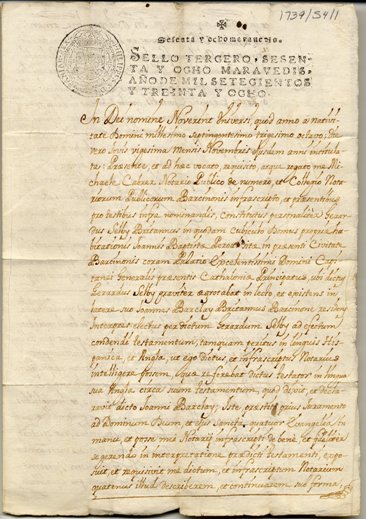
Selby died at Barcelona in Catalonia, Spain, on 20 November 1738. He was the owner of the George and Eleonora, then anchored in the port there. He died at the house of Juan Bautista Perotti in the presence of John Barclay, a resident of Barcelona, and his will was also witnessed by Ninian Browne an Englishman and Sir John Winder the British Consul. Selby instructs his skipper to continue the voyage and ship's business to its end. The document is in Latin and bears the intricate signs manual of three Barcelona notaries. In common with most of Europe, the ecclesiastical courts of England and Wales followed the Roman civil law rather than English common law, and such courts today still require notaries public in certain circumstances.
Ref: DPRI/1/1739/S4/1-2.
![]()
Inventory of John Tucker of Newcastle St Nicholas, master and mariner
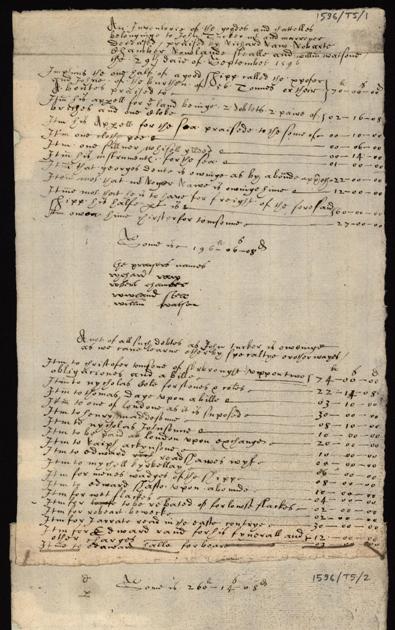
Tucker was master and part owner of the 56 ton ship the Christopher and John. The inventory and probate account entered by his administrator, a creditor, state that he died when his ship was cast aground at Elsinore (Helsingør) in Denmark and 'in danger to be utterly lost'. His crew under the command of Edward Rand succeeded in saving the ship. Upon his return Rand made a claim against Tucker's estate for extra provisions for the crew during this adventure, for the cost of getting the ship off the rocks, and for Tucker's funeral, totalling £12 2s. The inventory indicates Tucker was exporting grindstones and coal east into the Baltic, and carrying on his return flax and often probably timber as well for the English market. Bills of exchange were preferred to cash by merchants engaged in such trade, and the presence of one such London bill hints that Tucker's trading also extended to that port as well.
Ref: DPRI/1/1596/T5/1-2.
Copy of the will of John Bayles esquire of Rokeby, Tasmania
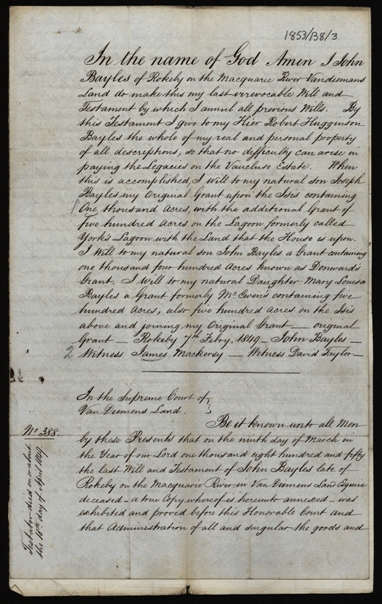
Bayles devises his estate of Vaucluse, near Conara, and lands on the Isis River in Tasmania to his children. Beneath the will is a part of a certified copy of the grant of administration by the Supreme Court of Van Diemen's Land to Bayles' heir Robert Hugginson Bayles made in March 1850. John Bayles died in April 1849. A year later Robert Bayles, then living at Vaucluse, appointed an attorney to administer the property in England. In September 1852 copies of the will and Tasmanian grant were made and certified in Hobart; and only in December 1853 was administration of the property in Durham diocese, estimated at £1,000 in value, granted to Robert Bayles' attorney at Durham. The length of passage between England and Australia at this time was between 3 and 5 months.
Ref: DPRI/1/1853/B8/3-5.
Affidavit of Emily Brown, administratrix of Jane Brown of West Clayton Street, Newcastle, spinster

Jane Brown came from a large family, and which at the time of her death was distributed across three continents. This affidavit was made by her sister who here swears that those of her family who had not already renounced administration before the court were living outside Great Britain and were not 'likely soon to return'. Various brothers and sisters were then living at Pictou in Nova Scotia, at New York, at Sonora in Mexico and at Calcutta.
Ref: DPRI/3/1854/A21/5.
Copy of the nuncupative will of Samuel Kenyon mariner of Boston, Massachusetts and Manchester, England
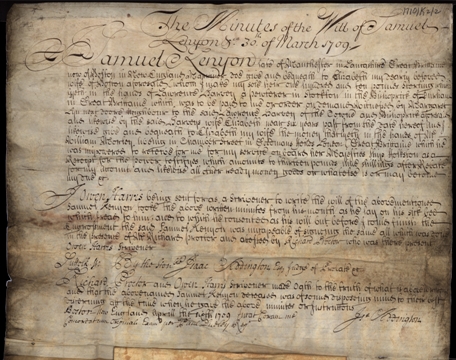
Kenyon was prevented by his illness from signing his will, but the circumstances of its publication are detailed in the second paragraph by the Boston scrivener then present. The will deals principally with monies owed to him in England and informs us he had once served on H.M.S. Folkston. The will was proved at Boston by Isaac Addington the judge of probate for Suffolk County in Massachusetts on 6 April 1709, and this copy of the will was certified by Paul Dudley, the probate register there. Annexed to this document (but not present here) is a 22 August 1710 grant of administration with the will annexed made by the Prerogative Court of Canterbury to John Babbage the attorney of Elizabeth Kenyon of Boston, Kenyon's widow and sole legatee.
Ref: DPRI/1/1710/K2/1-2.
Administration bond of Isaac Peart, master of the ship Shannon
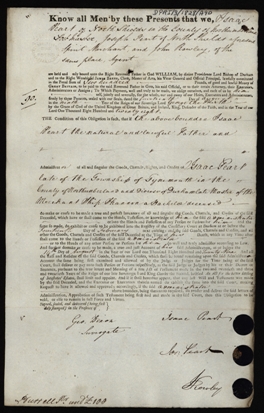
The bond proceeds in a standard way, stating Peart was a bachelor and that his estate was valued at £100, but on the dorse or back of the document is the sentence, 'The intestate was murdered at sea by Pirates.' Contemporary newspapers reported that having left the Mexican port of Campeche in the Gulf of Mexico in May 1824 bound for home waters, his ship Shannon was taken and burnt by pirates and her 16 crew murdered. Peart's telescope was found by the crew of H.M.S. Parthian in June of that year on the pirate schooner St Jose. The French invasion of Spain in 1808 precipitated the Wars of Independence in the Spanish and Portuguese New World colonies, and following the peace of 1815 the fleets of 'patriotic corsairs' commissioned by these new American states triggered the last great epidemic of piracy in those waters.
Ref: DPRI/3/1828/A90.
Caledonian Mercury, Edinburgh, Thursday, 23 September 1824; Issue 16086
| PIRACY AND MURDER. - For some time past much anxiety has been felt here, regarding the fate of the brig Pilgrim, Wilson, of this port. It was known that she sailed on the 15th of May last, from Campeachy, in company with the barque Shannon, Peart, of London, the former for Bristol and the latter for Cork, and both vessels being since amissing, the melancholy, but natural conjecture arose that they, with their crews, had fallen a sacrifice to the pirates infesting their homeward track. This conjecture has been fatally confirm- ed by the arrival of his Majesty's ship Parthian at Plymouth, corroborated by other sources of intelligence, from which it appears that the above vessels were captured and burnt by pirates at Laguna de los Terminos, and all on board sa- vagely murdered. On the 18th June the Parthian took a piratical schooner, armed with two long guns, 14 pounders, which she afterwards sent to Vera Cruz, and had fitted out to cruize for the protection of the trade. When captured there were found on board this vessel several articles suppo- sed to have been plundered from the Pilgrim and Shannon, consisting of flags, spy glasses, sextants, wearing apparel, papers, &c. On one of the glasses the name "Peart" was engraved, and the initials of Captain Wilson's name, (J. W.) were marked on the apparel, among the papers were a pilot certificate of the Pilgrim, and a list of the crew of the Shannon. There was also a letter bag, inscribed "Pilgrim of Greenock," found on board. Unfortunately the crew of the schooner, into whose merciless hands there can be little doubt those of the Pilgrim and Shannon had previously fall- en, succeeded in escaping on shore, when their vessel was captured by the Parthian, and consequently, for the present, all farther traces of the horrid deed are lost, and the particu- lars of the mournful tragedy are enveloped in doubt, We understand that the Pilgrim had about twelve hands on board, nine of whom belonged to Greenock. Captain Wil- son was a young man, and this was his first voyage in the quality of master. - Greenock Advertiser. |
The Times, Monday, 27 September 1824; Issue 12454
| The Parthian, 10, Hon. Captain Barrington, brought to Plymouth, from Mexico, 130,000 dollars, on merchants' account. She captured off Campeachy, the pirate schooner St. Jose, armed with a long gun amidships, two smaller ones, and a quantity of small arms: the crew having run the vessel on shore, escaped among the bushes, with a quantity of booty. On board her was found a list of the crew of the English ship Shannon, 16 in number, and other papers belonging to the English brig Pilgrim, besides several flags, sextants, spy-glasses, and a great quantity of wearing-apparel, all of which was English: the crews of the above vessels had doubtless been murdered by these villains. The schooner was taken to Vera Cruz, and there commis- sioned by Captain Barrington as a man-of-war, to protect the trade in that quarter. Mr. Bradily, an old passed midshipman, and a very deserving young man, was appointed as acting Lieutenant to com- mand her. |



